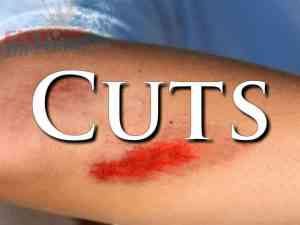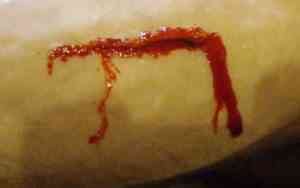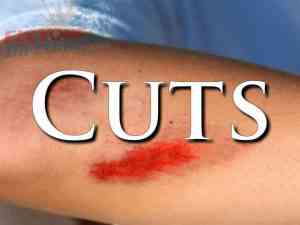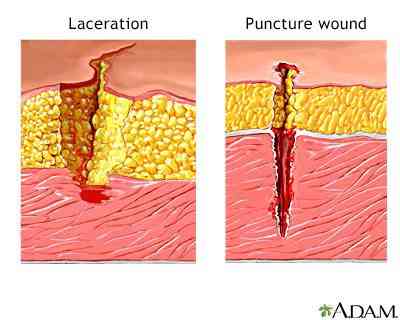Knowing What To Look For Will Help You Treat A Cut
How to treat a cut depends on what type of injury you sustain. Cuts can take many different shapes, forms, and sizes, and you can get them from a major crash, or a slip of you fork eating dinner at camp. There are the small surface cuts that barely break the skin and the deep lacerations that can potentially be fatal. There are the short paper cuts and the long serrated cuts. But either way, you slice it (bad pun), all cuts, no matter the type, you need to know how to perform basic first aid for cuts to help stop bleeding, prevent infection, and avoid other complications.

What Is A Cut?
A Cut is defined as areas of damage to the skin and underlying muscle tissue. A majority of cuts will bleed – a minimal amount on some occasions and a considerable and significant amount on others. The dangers of any cut lie in three different categories: location on the body, the depth of the cut, and the size of the wound.
For that reason, it’s always safer to carefully examine and diagnose the severity of any cut, no matter the depth or size or location, before wrapping it up and going about your business.
Laceration Identification
Determining how to treat a cut will have one symptom in common, an open wound on flesh. And most cuts will bleed to some degree but vary in the amount and the way the blood flows. Here are the symptoms you need to watch for:
 Some cuts will barely bleed, while others will gush large amounts of blood. The amount of blood and the way it bleeds will both play significant roles in properly treating each cut with basic first aid.
Some cuts will barely bleed, while others will gush large amounts of blood. The amount of blood and the way it bleeds will both play significant roles in properly treating each cut with basic first aid.
- Most cuts will result in some degree of pain. In some cuts and scrapes, the pain will be barely noticeable, while in others, it will be very intense. The degree of pain typically depends on the severity of the cut, but not always.
How To Treat A Cut Using Basic First Aid
Below are the steps you should take (in order) with each cut you encounter regardless of its size, depth, or location. These steps will help prevent further bleeding, diagnose the cut’s severity, and protect the wound from infection.
- Stop the bleeding. This is always your first objective. For minor cuts, this should require slight pressure with a clean cloth on the cut for approximately five minutes. For more significant cuts, it will need firm pressure with a clean towel for about 20-30 minutes.
- Don’t check the wound while stopping the bleeding. Lifting the cloth off of the wound while it’s still bleeding will prevent the wound from clotting adequately.
- If the bleeding does not stop, seek medical attention immediately. If the blood is flowing excessively or the bleeding hasn’t stopped despite your attempts, find medical help immediately as basic first aid isn’t enough.
- Clean the wound. Once the bleeding has been stopped, the next step is to disinfect and clean the wound. First, wash the wound with clean water. Next, remove any debris or dirt still in the injury, if possible. Then, clean the area using soap and a clean cloth.
Keep The Affected Are CLEAN
- Apply an antibiotic. Next, apply an antibiotic ointment (such as Neosporin) to the wound. This will help prevent infection and aid the natural healing process.
- Cover the wound. Place a bandage over the wound to prevent external bacteria from entering it. Important: Don’t leave the bandage on for longer than necessary. Doing so will slow down the healing process significantly. The human body requires oxygen to heal.
- Change the dressing. If you have to keep the wound covered for an extended period, make sure to change the dressing regularly. A good rule of thumb is at least once a day, and any time it gets wet or dirty.
- Get medical attention, if needed. If the cut is deep enough, it may need stitches. And unless you’re a badass like this guy, you’ll want to seek medical assistance beyond basic first aid. Don’t avoid this step if it’s necessary. Stitches keep the wound closed, which is crucial to preventing infection.
You might not even notice a cut until you see the blood due to adrenaline or just not paying attention. Either way, when you do notice any cuts, get working on first aid immediately to avoid any complications.
If you have any questions or anything to add, please leave them in the comments or on our FaceBook page!
Keep Reading – Burn First Aid Treatments






